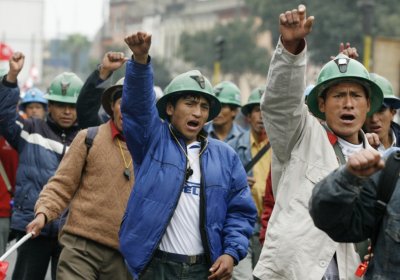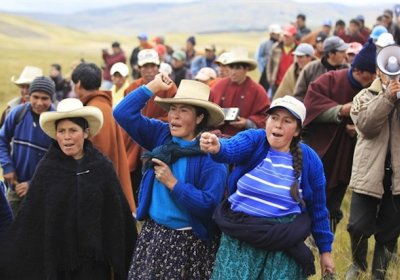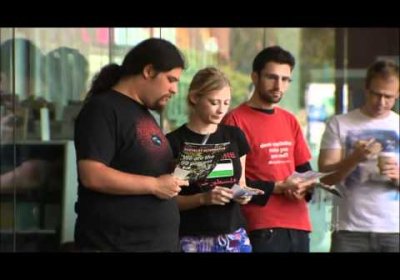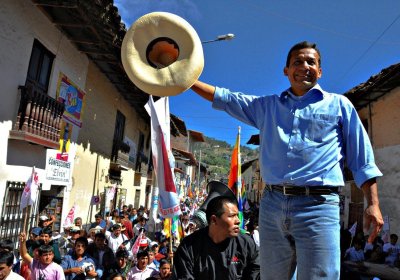The Peruvian government has renewed its commitment to several controversial mining mega-projects. The projects have provoked huge regional protests against the environmentally destructive expansion plans of foreign mining corporations.
Speaking at a mining industry conference held in the southern city of Arequipa on September 16, Minister of Energy and Mines Jorge Merino indicated that Conga (in Cajamarca), Tia Maria (in Arequipa) and Corani (in Puno) will be developed with the backing of President Ollanta Humala's administration.
Peru
The Conga gold and copper mining project is becoming one of Latin America’s most significant environmental battlefronts. It is pitting almost the entire population of the northern Cajamarca region of Peru against the invasive forces of the multinational mining industry and its governmental puppets in Lima.
In recent years, there have been many strikes and protests. This has led to hundreds of arrests, scores of injuries and several protester deaths.
Hundreds of protesters from the indigenous advocacy NGO Survival International gathered outside Peruvian consulates and embassies in London, Paris, Madrid and San Francisco on April 23. They had gathered to urge the Peruvian government to reconsider expanding the Camisea gas mega-project.
Camisea’s Bloc 88, deep in the Amazonian jungles of south-eastern Peru, is thought to contain over 10 trillion cubic feet of gas.
One year has passed since the community of Cajamarc, in Peru's northern highlands, rose up against the “Conga” copper and gold mine, a US$5 billion mega-project proposed by the World Bank-backed Newmont-Buenaventura consortium.
The unified cry of the protesters is still: “Conga no way!”
The region bordering the mine site is home to an agricultural population that relies on the natural highland water system. Destroying this precious and fragile asset would end the viability of their existence.
The highland agricultural community of Santa Rosa de Cajacuy, in Peru’s central Ancash department, has been severely affected by a toxic spill from the BHP Billiton and Xstrata-operated Antamina mine.
Antamina is one of the world’s largest sources of copper and zinc. It relies on a 300 kilometre high-pressure pipeline to pump resources from the mountains to coastal port facilities.
After a hostage crisis in which one of armed group Shining Path's (Sendero Luminoso – SL) factions abducted gas workers employed by a major multinational, a counter-insurgency operation was launched in the Apurimac-Ene River Valley (VRAE).
The stand-off was reported by the international media. But what has been largely ignored are the human rights abuses against VRAE civilian communities are being committed by the Peruvian military.
Tintaya is an open-cut copper and gold mine 4000 metres high in the district of Yauri, Espinar province, southern Peru. It is a spectacle of modern industrial devastation that contrasts jarringly with the timeless beauty of the surrounding altiplano landscape.
Finally, after years of aggravated environmental abuse, the mine's owner, Swiss-based Xstrata, will be investigated by Peruvian authorities.
After the discovery of large deposits, a copper mine was established at Tintaya in the mid-1980s. Extractive operations were hugely expanded when BHP bought the site in 1996.
Cajamarca, a town with tragic associations in Peruvian history, is the setting of another devastating imperialist onslaught.
In 1532, a band of Spanish conquistadores ambushed the Inca king Atahualpa in the central plaza of this Andean town.
The brutal spirit of conquista is alive and well in contemporary Cajamarca, in the form of the US-based Newmont mining corporation, an outfit with a slick PR machine and a very dirty environmental and human rights track record.
It’s another statistic showing up the criminal absurdity of Plan Colombia and Washington’s “war on drugs.”
Last year, according to recent United States Drug Enforcement Administration sources, Peru produced about 325 metric tonnes of pure cocaine, surpassing Colombia’s output of 275 tonnes.
For the first time since the early 1990s, Peru has emerged as the world’s leading cocaine producer. Bolivian production is also reportedly up.
In its traditional, folk medicinal form, coca is a blessing that dispels ailments such as indigestion and altitude sickness with remarkable efficacy.
Between 80 and 100 people gathered for an open-air Occupy Perth general assembly in Perth on October 22. It began at 11am and finished around 5pm. The main purpose of the assembly was to make plans for establishing a Perth occupation at the end of the Chogm Protest (taking next Friday, October 28) that would last at least throughout the CHOGM summit. There was quite a constructive discussion and a lot of enthusiasm to begin an occupation next weekend. Eleven working groups were established.
In the aftermath of Ollanta Humala’s June 5 victory in the Peruvian presidential election, the “investment community” and the international business press reacted with the hysteria of thieves who think they have heard a distant siren approaching.
Their first impulse was to cut and run. Peruvian stocks plunged amid fears that this “radical leftist” would put an end to the “good times”, levelling higher taxes on mining profits and perhaps nationalising key export industries.
In the final days of Alan Garcia’s rancid presidency, crimes against the Peruvian people are still being committed.
The department of Puno, bordering Bolivia in the country’s south-east, has now been added to a long list of locations where anti-mining protesters have been gunned down by security forces.
On June 25, six indigenous activists were reportedly killed and dozens more wounded when Peruvian police opened fire on a 4000-strong crowd occupying the Manco Capac airport in the city of Juliaca.
- Previous page
- Page 5
- Next page








